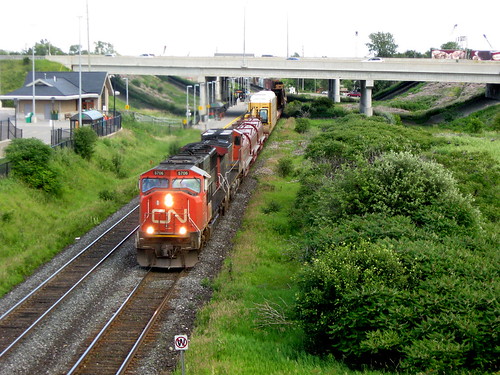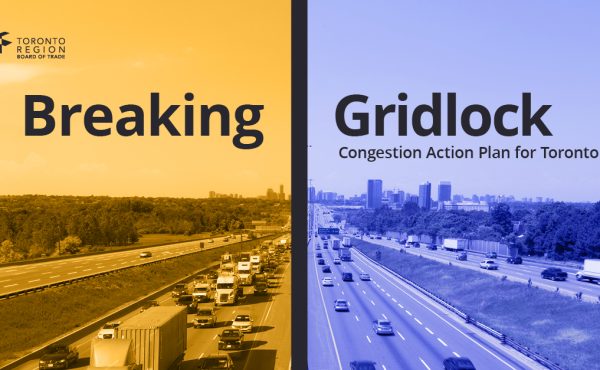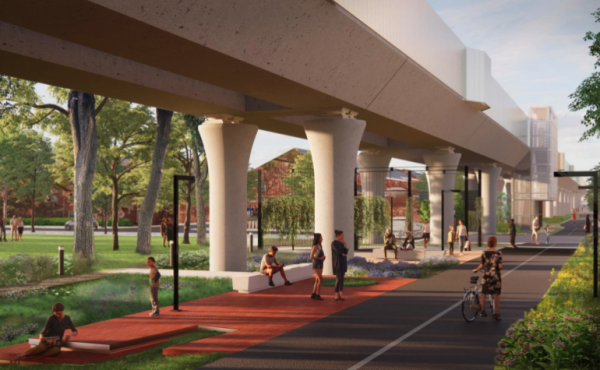 I’m not sure what it is about GO Transit. I want to think that it is an essential part of our public transit system. In many respects, it is: by providing a well-used commuter service, it has certainly reduced the need for highway expansion, which was its original intent (to address the need to widen the QEW). Yet despite some promising signs, GO has remained a auto-centric transit service. Instead of building new and larger highways, GO instead builds new and larger parking lots.
I’m not sure what it is about GO Transit. I want to think that it is an essential part of our public transit system. In many respects, it is: by providing a well-used commuter service, it has certainly reduced the need for highway expansion, which was its original intent (to address the need to widen the QEW). Yet despite some promising signs, GO has remained a auto-centric transit service. Instead of building new and larger highways, GO instead builds new and larger parking lots.
This car-centric approach is understandable to a degree. Some of its stations are in places where local public transit is limited tor non-existent, like Georgetown. Some stations, like Bramalea, Meadowvale, or Pickering aren’t going to easily transform into vibrant, transit-oriented communities. The only way to get some people from driving downtown is to build commuter stations with convenient parking in which to leave the car instead.
But GO’s auto-centric focus makes one wonder if the consultants, designers and engineers are oblivious to the needs of pedestrians. Maple, for example, is a station in a residential area. Yet it is completely fenced off from the subdivisions across the tracks. Perhaps there is the worry about pedestrians crossing the tracks illegally and dangerously, but at least a proper path down to Major Mackenzie would make some sense.
But the best example of this that I have seen is at Langstaff GO Station. Last year, a pedestrian bridge was finally built, connecting the GO trains (and the 407 corridor buses) with the York Region Transit/Viva and GO airport express buses on the other side of the busy CN Bala Subdivisions. The bridge is impressive, with elevators and stairwells on both sides, and provides an useful and important link.
But what I don’t understand is all the necessary fences. One fence divides the walkway from the railway. Fine, as the Bala Subdivision is not only a GO route, but also CN’s busy freight corridor to the north and Western Canada. But there’s also a fence blocking the path to the bridge to the adjacent big box plaza, specifically a Home Depot and a Tim Horton’s.
 Do not pass GO.
Do not pass GO.
Neither your average GO Station nor your average power centre is very pedestrian friendly. Even so, why would there be the expense and effort to barricade the two apart? The driveway that is beside the fence is not at all busy, and otherwise, one could, at least, grab a coffee or a cauking gun on their way home on Viva. As you can see in the first picture above, a very well-worn, wide, dirt path exists between the two, and wouldn’t deter commuters to use the lot as a park-and-ride, especially as the fence does not block access at all to the GO station from the lot. In the length of the fence, one could build a very shallow ramp that would at least negate the need for an elevator and power-assisted automatic doors at the bridge entrance.
However, on the Viva/YRT side, pedestrians must cross active bus driveways to reach the GO and YRT/Viva buses. An at-grade hazard we are to accept, but of course, pedestrians can not be trusted with trains, with their bells, lights and whistles. You’d even think even a simple pedestrian grade crossing, with bells and lights and gates, would have been cheaper and just as safe than the bridge? At least people in wheelchairs wouldn’t face elevator outages, all too common in our transit systems.
CN freight train from Langstaff/Richmond Hill Centre bridge






20 comments
I’m assuming that this is to discourage GO riders from parking in the Home Depot parking lot. This sounds similar to how Bayview Subway station turns its back on Bayview Village Shopping Centre, because the owners of the centre were concerned that commuters would use all of the parking spaces. Another example is Yorkdale, whose parking lot is locked with barriers so that commuters can only park in the garage adjacent to the subway station.
At the Rouge Hill station a locked gate separates the south platform of the station from the linear park. This would allow the GO tunnel to be reused as a safe much needed pedestrian park access. Further along, an out-dated sign at the east end of the platform indicates “No Trespassing” although the pathway of the park beyond is obviously intended for use as a walkway to the level crossing.
This station also has kiss-and-ride problems with many people parking in dangerous places to save a few seconds off their trip.
Some effective management at each station would avoid these situations.
Bayview Village also has a well-worn (although slightly treacherous) path between the station entrance and the mall. It’s pretty annoying.
At this Langstaff Station, what I understood was that there was initially negotiations to make the Home Depot, VIVA/YRT, GO station, and the bridge connect more directly. However, CN has their own setback guidelines on the tracks and pedestrian traffic. Unfortunately, no one really bothered to spend the time, effort or money to negotiate with CN so the fencing and all the stuff mentioned in the article came to be. The other set of happenings was that Home Depot wanted some money from VIVA/YRT at some point because they did want to prevent commuters from parking at their lot should there be a moe direct connection. At the same time VIVA/YRT countered with that they should help pay for the bridge and linkage costs, to which Home Depot balked and here we are.
This is not the only example of inconvenient pedestrian circulation at Richmond Hill Centre station. There are fences along the south and west sides of the bus terminal, and the only entrance is in the northwest corner. But the (official) park-and-ride lot is south of the terminal, and the bridge to Langstaff GO is in the southeast corner of the terminal. This means traveling about 150 m out of the way, which doesn’t sound like much but is a frustrating inconvenience since the connection appears to be so close.
Because of this design, the park-and-ride lot is underused and there is a significant amount of spillover traffic that uses the adjacent movie theatre parking lot instead.
Go is also still Diesel-Centric too.
Seems to me the tried and true “pay parking, but free with proof of purchase” method would eliminate Home Depot’s concerns. Sure they would have to pay someone to staff a both, but they would surely recover it from those GO riders who did elect to park there.
One easy thing to get around this problem is to have a Viva stop at Red Maple and Hwy 7. This way, people who need to transfer to the GO can just get off at Red Maple and walk straight to the GO station.
A Viva stop at Red Maple also allows pedestrian easy access to Tim Hortons, Home Depot, and all the other outlets on the west side of Red Maple such as Staples, Winners, etc.
A Viva stop at Red Maple also makes it easy for people who live in the Red Maple area to walk home after they get off the Viva. If you live in the Red Maple area, and you get off at Richmond Hill Centre, it is impossbile to walk home without doing one of the following:
-cross the bridge and walk around that very annoying fence
-walk around the big theatre and up to High Tech Rd while putting yourself at risk of getting hit by cars looking for parking
-climb the fence and cross the train track and walk on the grass up to the bridge
Richmond Hill Centre is the most pedestrian UNfriendly place.
A stop at Red Maple and Hwy 7 would solve these problems by allowing pedestrian access to GO, the outlets, and the homes around Red Maple.
I’m glad someone has mentioned this, as it is something that has bothered me for quite some time. For me, a Viva rider (but not a GO rider) the purpose of the bridge was to give me some sort of access to the stores across the rail tracks. The only way across prior to that was a ridiculous walk back west almost to Yonge, up on the bridge that already existed for car traffic over the tracks, behind the stores, and around. That would likely have taken a good 20 minutes.
So when this bridge was being built I was happy that I would now be able to actually get to the stores, like Best Buy, without having to drive. And then they put the waste of fence in the way. You can never win with transit these days… 1 step forward, 2 steps back.
Again, I think Viva needs a stop at Red Maple and Hwy 7.
The point of Viva is that it doesn’t have many stops. Easy access to Tim Hortons?
When discussing GO, people continually forget that it doesn’t own the property it uses. Except for the tracks on the Lakeshore line east of Pickering, GO runs on CP and CN track. It is privately-owned space, and as such, these railroads have their own policies about where pedestrian access to track is to be allowed. We can certainly argue about the value of these policies, but any critique of areas like this needs to factor in this reality. GO and YRT may have surprisingly little say when where they can allow their customers to access the Rights-of-Way.
That said, the general critique about the auto-centric nature of GO stations (particularly in suburban areas) is right on.
GO Bloor is another example of how auto-centric GO Transit is. It’s been open for how many decades without a link to the subway? It has an entrance facing the niehgbourhood beside it, but it’s fenced off, forcing people to use a single entrance from Bloor street.
Any chain link fence will be scaled by teenagers or kids. I know that I would have when I was a couple of years (or decades) younger.
You can also have the same sort of obstacles with cul-de-sacs that end with a fence barrier between the road and a transit stop on the other side.
In both cases, in time the teenagers and kids will create a break in the barrier by their constant scaling or creation of foot holds. Instead of accommodating the users, they will unfortunately eventually repair or build even more barriers.
Maybe if the city didn’t give a tax break to parking lots malls would have to charge for parking. Then they wouldn’t need to fence off their lots from GO stations.
“pedestrians can not be trusted with trains, with their bells, lights and whistles. You’d even think even a simple pedestrian grade crossing, with bells and lights and gates, would have been cheaper and just as safe than the bridge?”
Nope. Pedestrians (especially those wearing earphones) and drivers seem to get stupid when confronted with level crossings, thus the worrying number of accidents reported every year. Their stupidity disrupts the entire system since the police have to go to the scene and the train driver is likely to be unable to continue.
Asher: GO is owning more and more pieces of track. Here’s how it breaks down:
Lakeshore: Pickering to Oshawa (GO Sub)
Milton: Strachan to West Toronto (CP Galt Sub)
Georgetown: Strachan to Halwest (near Bramalea Stn) (entire CN Weston Sub)
Bradford: Snider (CN bypass) to Barrie (CN Newmarket Sub, may also purchase south section as well)
Stouffville: Hagerman (CN bypass) to Uxbridge (CN Uxbridge Sub)
There’s lots of places in Toronto where pedestrians must use level crossings, even pedestrian-only crossings in Scarborough, though the trend is long, winding ramps to overpasses or tunnels. Tunnels or underpasses, which are typically shallower than bridges over rails are tall, are ideal, but of course have personal safety issues.
Tomorrow, I’ll discuss Milton, another suburban GO Station, which has a different approach.
A.R., GO Bloor is hardly “another example of how auto-centric GO Transit is”.
This station offers no parking wahtsoever.
I agree that ideally the walk should be shorter from the subway to Bloor GO station, but walking (including subway + walking) is the only way to get to it.
The Richmond Hill Terminal is one of the biggest white elephant projects I’ve ever witnessed in public transit.
Before the Viva, one could connect to the Langstaff GO from the 99/C Yonge bus which had excellent frequency, for York Region standards (10 minutes during rush hour, 15-20 minutes off peak, 30 minutes fringe). You would get off at Langstaff Rd, and walk a short distance to the GO where you could connect with services not only heading downtown, but to various destinations to the east and west of Toronto.
This bridge should have been the FIRST thing completed when Viva was launched. Instead, the county builds an over sized and exposed bus shelter so that all the SUV driving yuppies can feel good that their tax dollars are being spent on “high quality” transit – for other people.
When Viva launched, the 99 bus was cut back to every 20-30 minutes at all times I believe (maybe 15 during the rush hour, cannot remember), and there was no stop at Langstaff Rd – not even temporary. So how were people to get to Langstaff GO by transit now?
1. Walk down the Highway 7 – Yonge ramp to Yonge St, cross underneath both Highway 7 and Highway 407 waiting for gap to get passed the on and off ramps to Langstaff Rd (and you think crossing under the Gardiner is bad?), then walk to the GO station from there.
2. You can walk along the train tracks through the RHC parking lot to Langstaff Rd. However, the path is unofficial and possibly illegal, and is filled with dead rats I’ve been told.
My conspiracy theory as to why the connection to the GO was made so difficult is so that people would take (inadequate) Viva service instead of GO to get to York University and various destinations in Markham. The Viva ride from RHC to York U is close to 40 minutes if I recall, and included a stopover at The Promenade Mall and a poorly designed left turn at Keele that takes several long lights to make. The GO ride is only about 15 minutes.
Maple GO station does indeed have a proper path to Major Mackenzie. I am puzzled as to why Sean would think otherwise. Some paths are well-hidden, but this one is clearly visible and easily accessible both from Major Mackenzie and from the GO station.
My only beef is that the stairs to Major Mac should have a bicycle gutter, but that is a bike issue, not a pedestrian issue.
Similarily, there is a path from the north end of the platform leading to the access road to the nearby subdivisions.
The subdivisions across the track have excellent access to the station. Perhaps a bridge across the track right at the platform would shorten the walk, but I am not so narcissistic as to demand exclusive infrastructure to my doorstep!